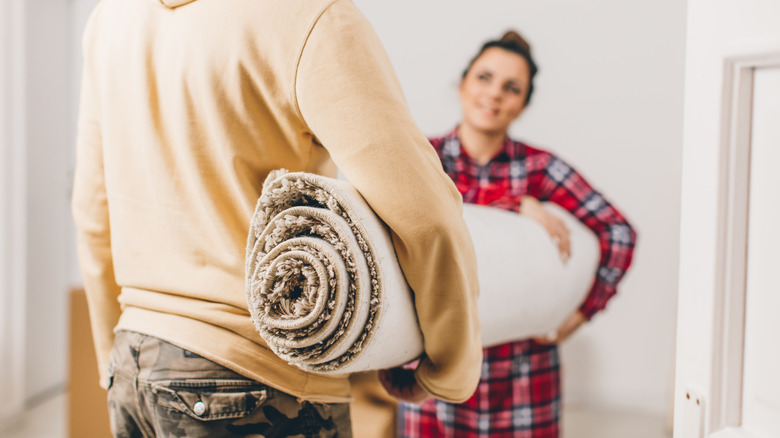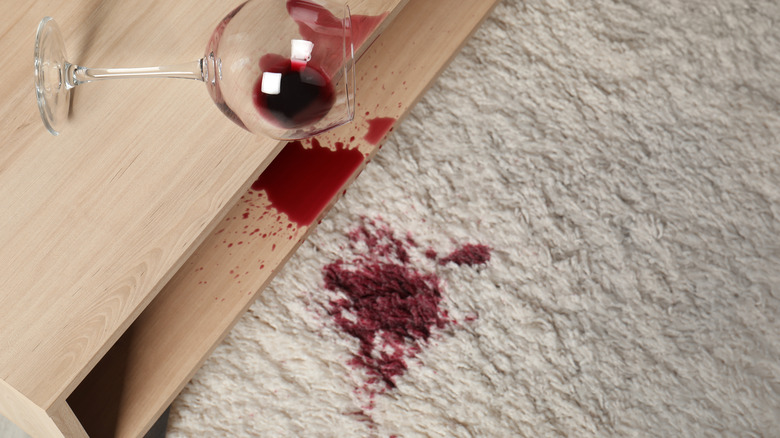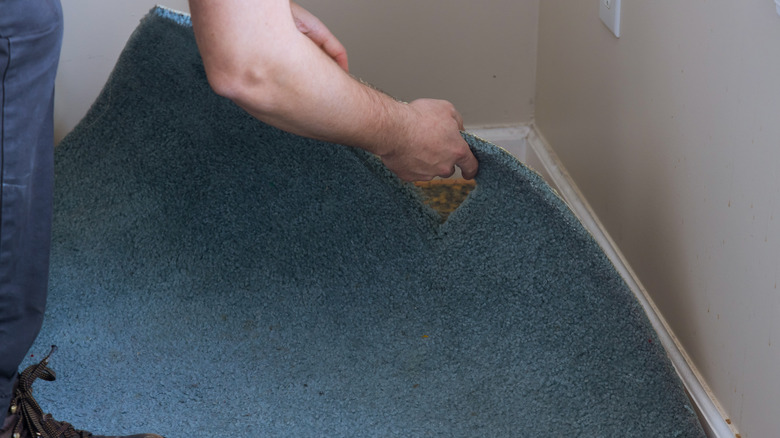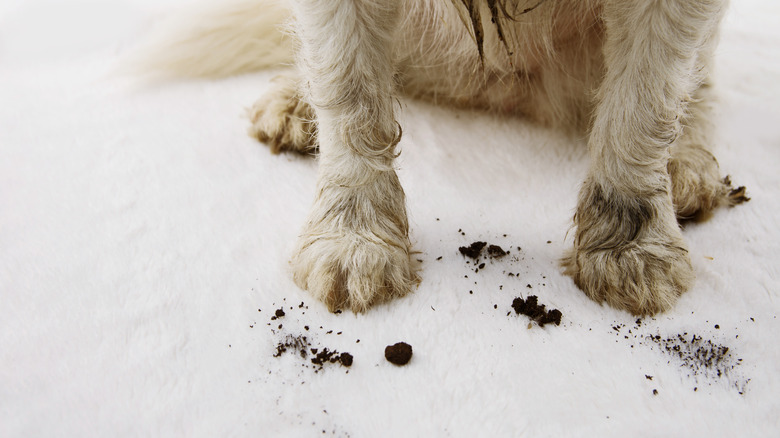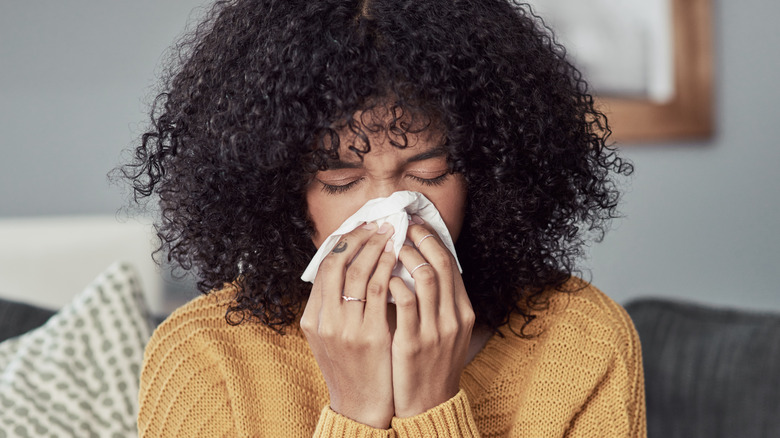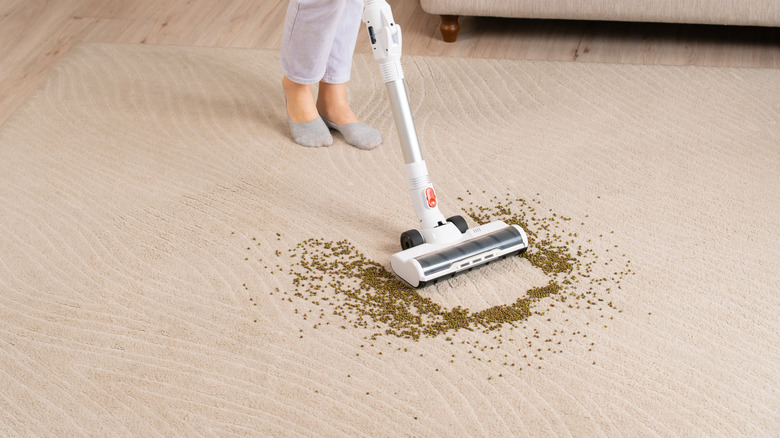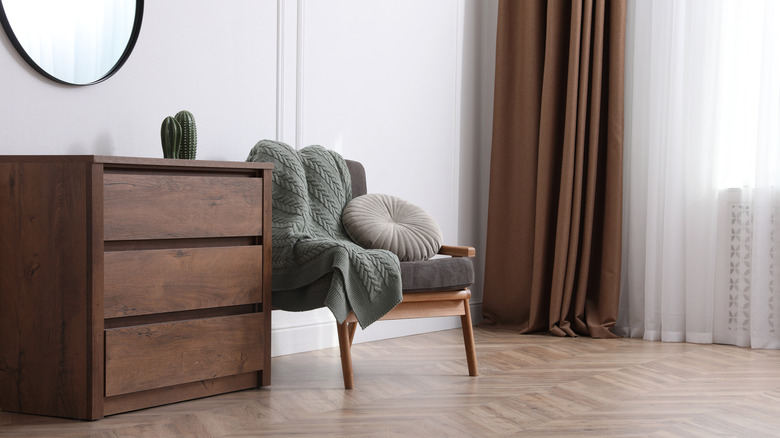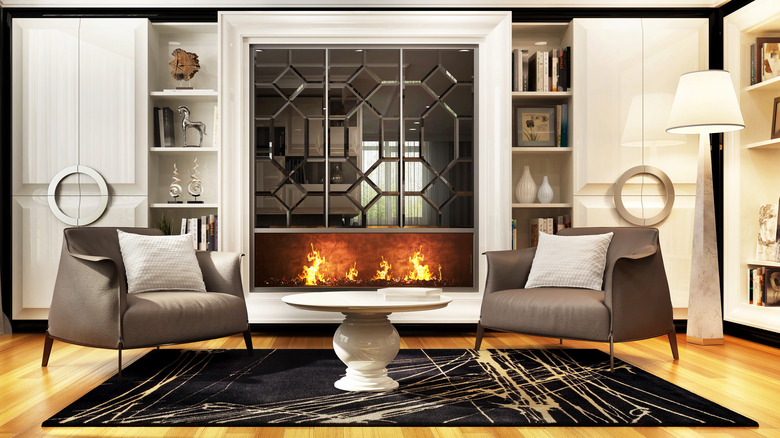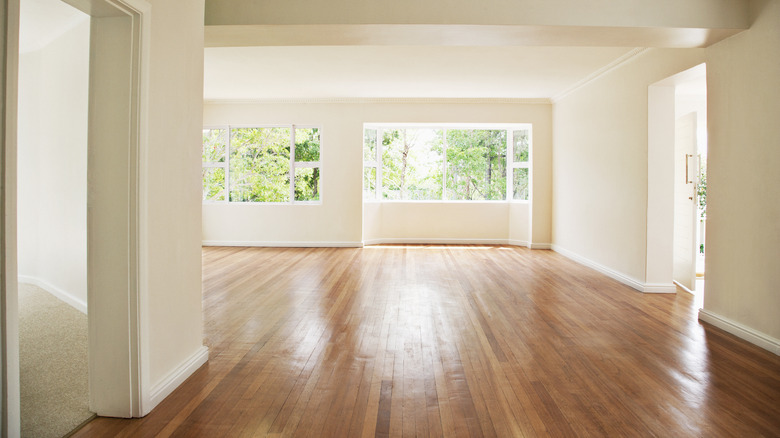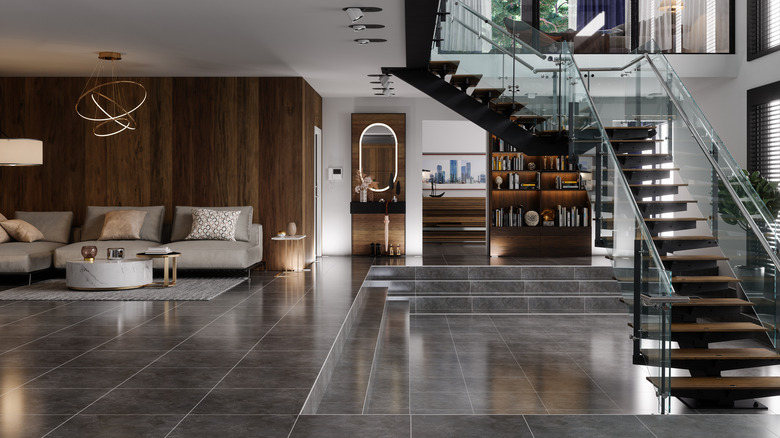Why People Are Getting Rid Of Carpet Flooring (& What They're Replacing It With)
Once upon a time, when walls were covered in patterned paper, televisions were carved from huge wooden boxes, and toilet seat covers made of fabric were a thing, it would have been difficult to imagine a home without carpets. Plush, lush, and pleasing to both eye and foot, carpets insulated a room and came in a wealth of colors and patterns. Yet design trends have seasons, and carpets are no different. More and more people have decided to ditch their beloved carpets in recent years and replace them with new styles of flooring.
Although a carpet can add comfort to a room, over time, it can accumulate a lot of unwanted dust, grime, and unsightly stains, and become a little frayed at the edges. When compared with some of its popular replacements such as hardwood flooring and large area rugs, carpeting begins to appear like an interior relic from a bygone age. It is not as easy to clean, can smell a bit funky over time, and has a habit of harboring bacteria and other unpleasantness. The types of flooring people are opting to replace it with are a lot sleeker, more hygienic, and offer a far more dynamic and contemporary vibe to freshen up your home. Let's strip things back to the floorboards for a closer examination of why King Carpet is on his way out and who's claiming the throne in his absence.
They are difficult to keep clean
When a plush carpet is first rolled out on your living room floor by installers, it seems welcoming and pristine. Sadly, no rug is immune to the dirt, debris, and sheer clumsiness of everyday life. Unless you're a 24-7 cleaning machine, they are almost impossible to keep box-fresh. You cannot simply move a mop over them and eradicate a multitude of sins like you can with other types of flooring. Instead, you need to get on your knees and blot and scrub a spill before it becomes a stain.
Additionally, you'll need to take a steamer to carpets and deep clean them on an annual basis to reach the parts every day cleaning simply cannot. This begs the question, is it worth it? To compound matters, after you've cleaned them, carpets still have a habit of looking dirty. This is because when they age, the fibers begin to fray. When you scrub those fibers with your cleaning products or tools of choice, you're aggravating an already bad situation. Other mistakes you can make when cleaning your carpet are using too much water, trying to tackle industrial-strength stains, and not allowing it to dry properly. When faced with such an uphill challenge, it's no wonder so many people are opting for an easier life with more hassle-free replacements.
Carpets can make your house look worn and tired
When moving into a new house, the first task on top of most people's to-do list is to rip up the carpets because they often have a habit of making a home look old and worn. "To most buyers, wall-to-wall carpeting is something to be removed," Allison Chiaramonte, a New York real estate agent, told Forbes. Just as you build from the base up, you should always remember the floor is the focal point, and you need to get it right if everything else is to fall in line. Giving the walls a new lick of paint can work wonders, but if the carpet is dated and stained, it has a habit of making your well-chosen wall colors appear out of place and out of time.
"There is a lack of flexibility in a wall-to-wall carpet, which doesn't appeal to the modern buyer," Chiaramonte explained. You can't change the color, you're stuck with the texture, and there is nothing you can do to remove permanent stains. Replacing the carpets with more contemporary and clean types of flooring is the perfect foundation for your new decor scheme.
Carpets are not really pet or child-friendly
Watching a dog race around the house with a reckless joie d vire is a happy sight — that is until you realize it still has mud on its paws and is casually treading dirt into your carpets. Likewise, the cozy touch that a cat might bring to a household is quickly displaced when it mistakes the living room carpet for its litter tray. Dogs and cats may like to roll around on rugs, but all that fur and dirt is being rubbed deep within. Additionally, many dogs and cats have a habit of clawing and digging at a carpet until it is threadbare and a proper eyesore. Because of this, carpets might not be the best pick for pet families.
As for small children, they tend to view carpets like a giant playground where spilled milk and upturned dinner trays are a way of life. On the plus side, it may cushion their numerous falls, but on the downside, it'll also absorb and carry each of those spills. Whereas alternate types of flooring such as tile and vinyl wood are easy to clean because the mess stays on the surface, on carpets, it infiltrates its core. This is a big factor if your household includes small children and pets who are not toilet trained.
They can be a nightmare for allergy sufferers
As all allergy sufferers know, allergens can hide in the most inconspicuous places, and carpets are one of them. For example, the materials they're made of can trigger sneezes and itchy eyes. The carpet pile can be made from a number of fibers, including wool, polyester, polypropylene, nylon, and sisal. Additionally, the padded carpet layer is usually made of recycled materials and could contain allergy-inducing substances such as styrene and formaldehyde. Because children tend to play on carpets, they are at greater risk of the allergens and irritants they contain.
By their very nature, carpets also tend to trap pet dander, dust mites, and mold spores. All of which can cause people to sneeze and itch. Although vacuuming carpets with a HEPA-certified vacuum can help to remove allergens, the beater brushes can't get down to the very bottom of the carpet and remove the dust stuck between the fibers. Because of this, it's probably best for severe sufferers not to have carpets in their home full-stop and replace them with an allergy-free alternative.
Carpets have a habit of harboring bacteria and smelling unpleasant
If you've ever walked into someone's house and been nearly knocked out by an unpleasant odor emitting from within, the chances are their carpet is the culprit. All the things bacteria is made of — such as the stuff you find on the bottom of your shoes, the accumulated matter pets bring in on their feet and coats, the crumbs that fall, and the drink that is spilled — all converge within the layers of your carpet and can cause a right stink. Moisture is a particular problem when it comes to odorous carpets. It's not just absorbed from spills, but from the air, and once it sets in, it can lead to a riot of dangerous mold and mildew forming in areas you cannot see but can certainly smell.
It's an unpleasant fact, but according to a poll by United Carpets and Beds, only 63% of people remove their shoes when they're at home. Every time someone walks on that carpet, it sends clouds of dirt, dust, and germs into that air and reduces its quality significantly. It is estimated that each square inch of carpet may contain up to 200,000 bacteria, making it dirtier than your average toilet. And don't make the mistake of thinking the bacteria found in carpets don't pose a real risk to your health. Salmonella is often found in its fibers due to people treading in animal feces. Likewise, campylobacter thrives in the dampness common to many carpets, which can lead to dysentery. E.coli can also enter your carpet through people and pets walking upon it.
Vinyl wood flooring is a popular carpet replacement
Now that you're aware of its negatives and the reasons why carpet is fast going out of fashion and function, you're probably wondering what a suitable alternative is. Well, many people find that vinyl plank flooring is the perfect replacement. As a flooring option that can be tailored to resemble everything from stone and marble to wood, its affordability, practicality, and functionality make it a popular choice among many. It's mostly made from PVC with a cork or foam backing underlay, making it a water-resistant and durable pick. This is also designed to absorb sound and make it feel softer underfoot.
Not only is it a cheaper option than hardwood floors, but vinyl flooring offers more protection against the damage that kids' toys and your dog or cat's nails can do to a floor. Although it is cost-effective, long-lasting, and perfect for areas that experience a great deal of wear and tear, vinyl flooring does not have the same resale value as hardwood or stone floors. It is not possible to refinish vinyl flooring, and when damaged, it must be replaced. However, as a low-maintenance, affordable, and comfortable alternative to carpets, you cannot go wrong.
Large area rugs offer a versatile and stylish substitute
If you're itching to replace your carpets but cannot abide the thought of having a living room or bedroom devoid of plush and comforting material underfoot, then maybe large area rugs are the perfect choice for you. They are a perfect way to add a little warmth and softness to tile or wood floors, and, unlike wall-to-wall carpeting, they can be easily removed and replaced. As well as being affordable and flexible, they do not need to be installed by an expert fitter.
Although rugs are made from the same material as carpets, they are usually a lot easier to clean since you can bring them outside for a thorough scrub with a bristle brush or pressure washer. Admittedly, the larger and thicker ones will have to be cleaned in the room or via a professional, much like a wall-to-wall carpet. However, with the lighter and smaller ones, you can simply pick them up and move them outside for their yearly wash. The time-honored tradition involves shaking or hanging the rug up and using a beater or broom to beat the dust and debris out. Alternatively, you could simply vacuum both sides and suck up all that hard-to-reach dirt. Before cleaning the rug, always check the materials it is made of and the manufacturer's advice. Before applying any cleaning product, spot-test it on a small spot on the rug to ensure it doesn't ruin the integrity of your colors. If you really want to make life easy on yourself, you could opt for a rug that is designed specifically to be cleaned in a washing machine.
Hardwood floors are a timeless and classy alternative
You'd have to search far and wide to find someone who doesn't like the timeless vibe that hardwood floors exude. They are a lot easier to clean than carpets. You can sweep them with a soft-bristled brush, or gently vacuum them, and they're good as new. For more pesky stains or a deeper clean, a wood cleaner is advised. Rather than buying one with waxes or polishes, simply make one with 1 gallon of warm water and a 1/2 cup of vinegar. Hardwood flooring and moisture do not agree with one another, so ensure your mop is lightly damp and not sopping wet.
Perhaps the major advantage that this type of flooring has over carpets is that it won't just last a lifetime if cared for properly, but it will last for generations. With a square foot of hardwood costing an average of between $6 to $12 — and that's without taking the installation costs into account — you will incur quite a significant initial expense. However, it is estimated that hardwood flooring can add 3% to 5% to your home's value. Whereas the first thing many people do when moving into a new property is to rip the carpets up, they tend to leave hardwood flooring where it is because of its universal appeal. Even if it looks a little worn around the edges, it can easily be restored to its former glory in a way carpets cannot by simply sanding it down and applying a new finish. And if a small area suffers from extensive damage, you always have the option of replacing a plank or two!
Tiles are having something of a moment in living rooms
For a long time, a tiled floor has been the prerogative of kitchens and bathrooms, and was considered a bit of a faux pas for any other room in the house. However, all that has changed, and tiles are having something of a moment in living rooms as a replacement for carpets. The major appeal of tiled flooring is it is one of the cleanest types of flooring you can buy. Spills and messes can be easily washed away with a mop to leave your tiles looking pristine and clean once more. (Although some tiles are pretty immune to staining, it's worth bearing in mind that cement and natural stone tiles are far more susceptible to blemishes, so pay special attention to material and porosity when choosing them.)
As well as being durable, tiles offer a lot of choice when it comes to design. They come in a wealth of colors, patterns, and textures. The three most common materials include marble, porcelain, and ceramic. However, there is a growing trend in living rooms for wood-effect tiles. They combine the best of both worlds, but without the careful cleaning that hardwood floors require. Made from porcelain, they are much stronger than natural wood or PVC and don't easily sustain scratches or chips. You can clean them with everything from vacuums to steam mops, and they won't fade from sunlight like other flooring options.
